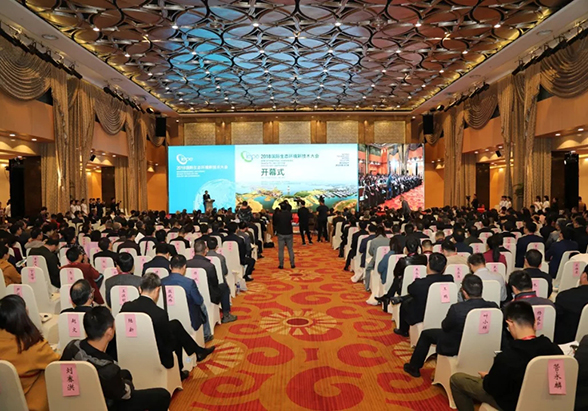Green growth relies on policy and institutional setting

The forum on green growth of the 2018 International Conference on New Technology for Ecology and Environment took place at Nanjing International Exhibition Center. Before the opening ceremony of the forum, distinguished guests visited the center. Photo: DEEJP
NANJING—Green growth requires appropriate policy and institutional setting, said experts at a forum of the 2018 International Conference on New Technology for Ecology and Environment in late October.
Green growth is a new development model that is conducive to resource conservation, environmental protection and ecological improvement under the constraints of the carrying capacity of environmental resources, said Bao Cunkuan, a professor from the Department of Environmental Science and Engineering at Fudan University.
“Green recycling and low carbon development is the direction of the technological revolution and industrial transformation of the current era, and it is also the most promising development field,” said Sun Keqiang, a research fellow at the Jiangsu Provincial Academy of Social Sciences.
Bi Jun, a professor from the School of the Environment at Nanjing University, said that now with high environmental risks, environmental health as a goal, and big data applications, green growth needs to consider multidimensional development goals and build healthy, smart and safe cities.
Enterprises are the backbone of green growth, residents are its active participants and supervisors, and the government is the last line of defense to achieve it, Sun said, adding that green growth must rely on external coercive forces provided by the government.
Bao suggested that the central government should strengthen macro-control and guidance of the local governments for green growth, motivate them and enhance their sense of responsibility. Bao also suggested promoting the coordination of different administrative regions and carrying out strategic environmental assessments with the concepts and principles of green growth as the benchmark for evaluation.
To translate the concept of green growth into actual action, it is imperative to foster new drivers for development; promote entrepreneurship in industries concerned with ecology, green growth and sustainable development; and facilitate smart, green, healthy and safe consumption. It also requires developing green finance, setting up green growth funds and fostering new advantages in green exports, Sun suggested.
The government needs to support the construction of green cities, smart cities and forest cities and encourage the development of new industries such as energy conservation, environmental protection and new energy, along with the green optimization of traditional industries. Sun added that agricultural modernization needs to be furthered by embarking on a road that seeks high quality, high efficiency, ecological security, resource conservation and environmental friendliness.
Sun also suggested shaping a new pattern of coordinated regional development in which elements flow in free order and in which main functional area planning is constructive and effective, ensuring equal access to basic public services. The carrying capacity of environmental resources must be considered, Sun continued. It is also important to support the development of low-carbon recycling industrial systems based on green agriculture, green industry and green services.
(edited by CHEN ALONG)
